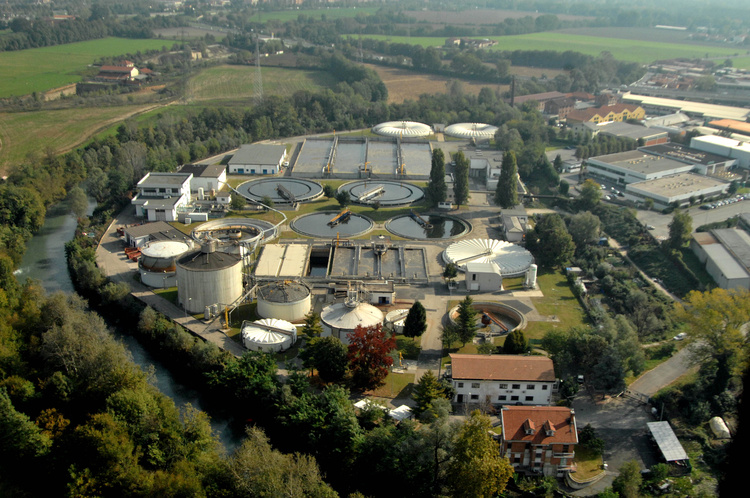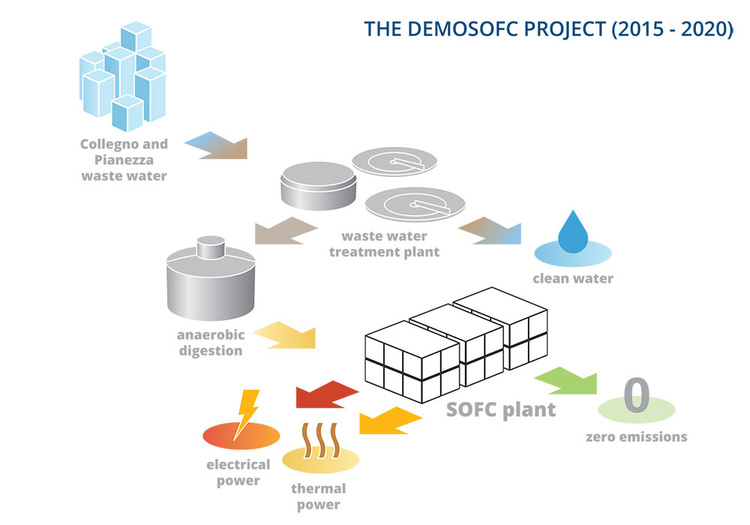The articles of the current edition are available on the new site.

Demosofc is the first industrial size biogas fed fuel cell plant in Europe and it is installed at the SMAT Collegno wastewater treatment plant premises. Solid Oxide Fuel Cells (SOFC) are fed with biogas produced as a by-product of the wastewater treatment process. The fuel cell technology can guarantee a production of electricity and heat with high conversion efficiencies and near-zero emissions to atmosphere (NOx, SOx, PM).
Born from a EU funded project within Horizon 2020 Program, coordinated by Politecnico di Torino and realized thanks to the technology from the finnish company Convion and the collaboration with Imperial College London, DEMOSOFC is a state-of-the-art plant, capable of covering 30% of the energetic requirements of the SMAT plant in Collegno, by reusing the gas coming from wastewater treatment process of both civil and industrial discharges in the towns of Collegno, Grugliasco, Rivoli and Villarbasse, covering an area with almost 180’000 inhabitants.
At the end of January 2020, data from the operation of the plant – started in October 2017 – have been analyzed in order to evaluated energy and environmental benefits of the proposed solution.
During the analyzed operating period, the plant worked for more than 10’000 hours considering the two SOFC module currently installed. The average power produced in the same period – 2 years and half – is 40 kW electrical (imagine that the electric meters installed in residential buildings have a maximum power of 3 kW, so average DEMOSOFC power was equal to around 13 meters).

The total electrical production – which was been completely self-consumed by the wastewater treatment plant – is equal to more than 450 MWh of electricity, which corresponds to the annual consumption of around 113 families of 4 people. This electrical production has generated an economic saving higher than 60’000 € (energy self-consumed and not bought from the grid) while the heat recovery from the SOFC exhaust gases has generated a saving of around 18’000 € (expressed as natural gas not bought from the grid). These savings are currently ‘limited’ by the reduced number of operating hours, due to the experimental nature of this system. If the plant was operated like an industrial site and worked for 90% of the total time at an average power of 100 kW electrical, the saving for the wastewater treatment plant would have been around 250’000 € only for the electricity production.
NOx emissions, measured onsite, are lower than the detection limits of the instruments used: NOx < 20 mg/m. If we consider a safety value of the emission equal to the detection limit (even if the real emissions are probably much lower) and we compare this number with the emissions from some biogas-fed internal combustion engines (standard competitive technology) installed in the SMAT Castiglione plant, the saving generated – in the analyzed operating period when the plant was running – is 565 kg di NOx, which is equal to the emissions from around 327 city cars in one year. The reduction in NOx emissions of the SOFC technology compared with the internal combustion engines is higher than 87%.

For what concerning the CO2 emissions, the high electrical efficiency of the SOFC system (50%) compared with an internal combustion engine (40%) leas to a reduction in the emissions for every kWh of electrical energy produced. Considering the entire DEMOSOFC operating period until the end of January 2020, the SOFC system generated a saving in CO2 emissions of 34% (which would have been released if the energy was produced with a traditional engine). If we consider the same city car, which travels for a total yearly distance of 15’000 km, the production of CO2 is equal to 2 tons/years. The saving generated by the DEMOSOFC site has been thus equal to around 17 city car equivalents.